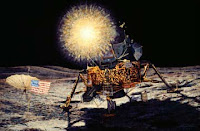The Greenwich Workshop has asked for our assistance in selecting the next release by Artist/Astronaut Alan Bean. Email or call us (Toll-Free 1-877-444-0777) with your preferred first and second choices from the four images shown below, or choose different images from one of Alan Bean's books. Please reply quickly and we'll forward your comments to the Greenwich Workshop's selection committee.
When Pete Conrad and I came down the ladder for our first walk on the Moon, all we had with us were the clothes (and backpacks) on our backs. Most of our scientific equipment was stowed in fold-down compartments on the sides of the lunar module descent stage. Pete is working at the right front fold-down compartment, the Modularized Equipment Stowage Assembly, offloading things we will need. We've already set up the large S-band antenna to improve voice and television communications with Earth. This painting emphasizes the size of the lunar module. As I looked at it on the Moon, it seemed much bigger than I remembered just four days previously back on the launch pad of Kennedy Space Center. It was a friendly home in a faraway world. - Alan Bean
Hadley Rille was one of the most visually exciting features we visited on our six lunar landings. Canyon-like, it meanders almost 70 miles. From this point of view looking north, the rille is about 1,100 feet deep and three-quarters of a mile wide. We can see the sunlit far wall as it moves left to right just beyond Dave Scott and Jim Irwin. It then turns northwest to disappear in the distance, its east wall in shadow. Scott is using his hammer to knock small pieces off a lonely boulder. Irwin is back at the lunar rover, getting the rake ready so that he can collect a variety of small rocks near the boulder. Hadley Rille was formed by flowing molten lava some 3.3 billion years ago, the boulder probably blasted out a large crater some 17 million years ago. - Alan Bean
Falcon, the Apollo 15 lunar module, sits on plains of Hadley. The Apennine Mountains are on the horizon and the scene is near the eastern edge of Mare Imbrium, the right eye of the man in the Moon as seen from the Earth. Dave Scott and Jim Irwin have gone for a ride in their new electric rover. We can see where the rover's woven piano-wire tires made their distinctive mark in the soft gray lunar soil. Dave would later say, "These mountains were never quickened by life, never assailed by wind or rain; they loom still and serene, a tableau of forever. Their majesty overwhelms me." Claude Monet is my favorite artist and with him in mind, I have not painted the Moon the neutral gray I saw with my astronaut geologist's eye, but a more beautiful combination of hues that I saw in my astronaut artist's eye. - Alan Bean
I painted the view to the east past the Lunar Module Antares shortly after Al Shepard and Ed Mitchell began their trek toward Cone Crater. The Sun is just peeking over the top of their spaceship, making it difficult, even painful, to look in that direction. The sky is painted how it looks there: a shiny, patent-leather black. You can't see stars because the Sun makes the surface so bright that your irises close way down. - Alan Bean
 |
| Home Sweet Home |
 |
| Hadley Rille |
 |
| Mountains of the Moon with the Lunar Module Falcon |
 |
| Sunrise Over Antares |